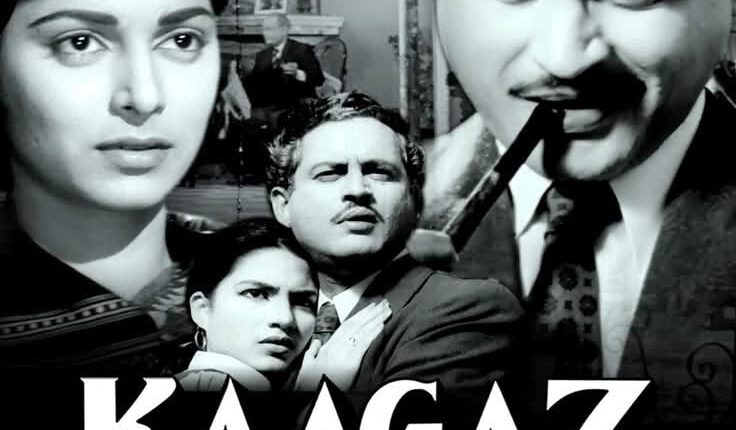Kaagaz Ke Phool (1959): A Cinematic Elegy to Art, Fame, and Human Frailty
A timeless Indian film about fame, love, and an artist's lonely heart.
In the canon of Indian cinema, few films occupy as significant and enduring a place as Guru Dutt’s Kaagaz Ke Phool (1959). Initially dismissed as a commercial failure, the film has since been re-evaluated as a masterpiece of introspective storytelling and visual artistry. Today, it stands as a landmark not merely for its narrative or performances but for its profound engagement with the nature of fame, creativity, and human vulnerability. As both a deeply personal work and a pioneering cinematic experiment, Kaagaz Ke Phool transcends its era, marking a pivotal shift in the language and sensibility of Indian filmmaking.
A Mirror to the Artist’s Soul
At its heart, Kaagaz Ke Phool is the story of Suresh Sinha, a successful film director whose life unravels under the pressures of social prejudice, unfulfilled love, and the fickleness of fame. His relationship with Shanti, an actress he discovers and mentors, becomes the emotional and moral axis of the film—a bond both profound and doomed by societal expectations. Through Suresh’s decline, the film explores the fragility of artistic identity in a world that consumes creativity without regard for the creator.
This narrative is often read as Guru Dutt’s own lament—a reflection of his personal experiences in the Hindi film industry, marked by creative struggles and emotional isolation. By weaving his biography into Suresh’s fictional journey, Dutt elevates Kaagaz Ke Phool beyond melodrama into the realm of cinematic confession. The result is a work that functions as both narrative and meta-commentary: a film about filmmaking, a portrait of the artist as a solitary, misunderstood figure.
Visual Poetry and Cinematic Innovation
One of the most remarkable aspects of Kaagaz Ke Phool is its visual language. Shot in luminous black and white by V.K. Murthy, the film’s cinematography is not merely illustrative but expressive—a means of articulating inner states of mind. Murthy’s use of light and shadow, inspired by German Expressionism and Western classical cinema, imbues the film with a haunting, almost spiritual quality. The celebrated shot of Suresh seated alone beneath a shaft of light in an empty studio encapsulates the film’s central motif: the artist illuminated yet isolated, seen yet profoundly unseen.
Camera movements and compositions are equally innovative. The interplay of depth, perspective, and framing mirrors the psychological space of the characters, transforming physical settings into metaphors for emotional landscapes. Such visual experimentation was rare in mainstream Hindi cinema of the 1950s, positioning Kaagaz Ke Phool as a pioneering text in the evolution of cinematic form in India.
Music as Narrative Resonance
Complementing the film’s visual poetry is its soundscape, crafted by composer S.D. Burman. The songs function not as interruptions but as integral components of the narrative’s emotional architecture. Most iconic among them, “Waqt Ne Kiya Kya Haseen Sitam,” sung by Geeta Dutt, is a lyrical meditation on time, fate, and irreversible loss. Its melancholic refrain deepens the film’s exploration of impermanence—not only of love and success but of human life itself. In this way, the music becomes a parallel text, extending the film’s philosophical inquiry beyond dialogue and image.
From Failure to Reverence: The Evolution of Legacy
Despite its artistic ambition, Kaagaz Ke Phool was met with lukewarm reception upon release. Its introspective tone, tragic resolution, and deviation from commercial tropes alienated contemporary audiences. The film’s commercial disappointment profoundly affected Guru Dutt, leading him to withdraw from directing altogether. Yet, as decades passed, critics and scholars began to recognize the film’s groundbreaking qualities.
Today, Kaagaz Ke Phool is celebrated as a foundational work of auteur cinema in India, preceding by years the global rise of self-reflexive filmmaking movements such as the French New Wave. Its thematic concerns—the ephemeral nature of fame, the alienation of the artist, and the tension between private desire and public expectation—remain as resonant now as they were in 1959. The film’s rediscovery underscores a crucial truth: that visionary art is often misunderstood in its own time, only to be embraced later as prophetic and profound.
Conclusion: An Immortal Testament
Kaagaz Ke Phool endures as more than a film; it is a cinematic elegy—a mournful, beautiful reflection on the human cost of creation. Guru Dutt’s tragic, luminous vision captures the paradox of artistic life: the same light that illuminates the artist also casts the deepest shadows. In its synthesis of narrative, image, and music, the film articulates a universal truth about impermanence, longing, and the fragility of human achievement.
In the final analysis, Kaagaz Ke Phool is not just a milestone in Indian cinema; it is a timeless work of art. It speaks across generations, not only as a chronicle of one filmmaker’s soul but as a mirror held up to all who dare to dream, create, and endure…. Written by Ehtesham Soharwardi (Shamm).
Read More: Pakistan urges Afghan refugees to return to their homeland.






Comments are closed, but trackbacks and pingbacks are open.